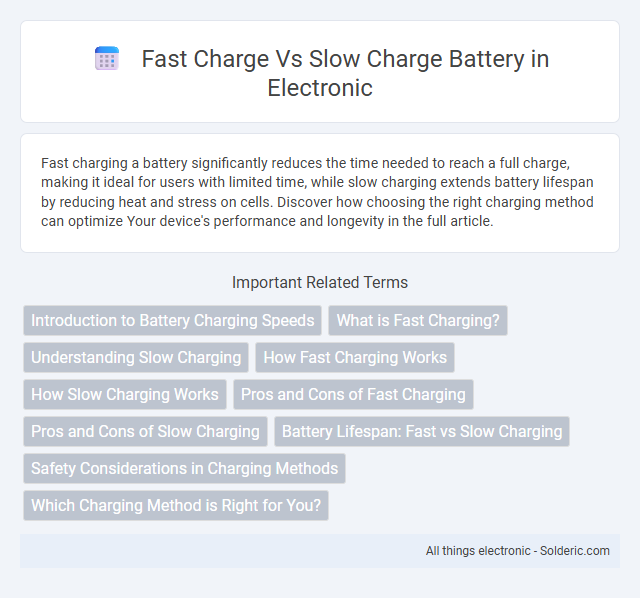Fast charging a battery significantly reduces the time needed to reach a full charge, making it ideal for users with limited time, while slow charging extends battery lifespan by reducing heat and stress on cells. Discover how choosing the right charging method can optimize Your device's performance and longevity in the full article.
Comparison Table
| Feature | Fast Charge | Slow Charge |
|---|---|---|
| Charging Speed | 30 minutes to 1 hour | 4 to 8 hours |
| Battery Life Impact | Higher degradation risk | Longer battery lifespan |
| Use Case | Emergency or quick top-up | Overnight or regular charging |
| Charger Type | High power chargers (DC fast chargers) | Standard power chargers (AC chargers) |
| Cost | Often more expensive equipment | Generally affordable |
| Heat Generation | More heat produced | Less heat produced |
Introduction to Battery Charging Speeds
Battery charging speeds are classified into fast charge and slow charge, each influencing battery health and usability differently. Fast charging delivers high power quickly to your device, reducing downtime but potentially generating more heat and strain on battery cells. Slow charging uses lower power over an extended period, promoting longevity and maintaining optimal battery capacity for long-term use.
What is Fast Charging?
Fast charging refers to the technology that supplies higher electrical current or voltage to a battery, significantly reducing the time required to reach a substantial charge level compared to standard slow charging. It typically involves specialized chargers and compatible devices capable of handling increased power delivery, such as Qualcomm Quick Charge or USB Power Delivery standards. Fast charging efficiency depends on battery chemistry, thermal management, and device circuitry to prevent overheating and maintain battery health.
Understanding Slow Charging
Slow charging a battery involves delivering a lower current over an extended period, which helps maintain battery health by reducing heat generation and minimizing stress on the cells. This method enhances battery lifespan and efficiency by allowing more complete chemical reactions within the battery, preventing capacity loss and degradation. Ideal for overnight charging, slow charging supports optimal energy absorption, making it suitable for electric vehicles and portable electronics requiring long-term battery preservation.
How Fast Charging Works
Fast charging works by increasing the electrical current delivered to the battery, allowing it to store energy more quickly than slow charging methods. Advanced battery management systems regulate voltage and temperature to prevent overheating and ensure safe charging speeds. Your device can reach up to 80% charge in as little as 30 minutes with fast charging, compared to several hours for slow charging.
How Slow Charging Works
Slow charging works by supplying a low current to the battery over an extended period, allowing ions to move steadily between the electrodes without generating excessive heat. This method minimizes stress on the battery's chemical structure, reducing the risk of degradation and extending overall battery lifespan. Slow charging is ideal for overnight charging, providing a safe and energy-efficient way to replenish battery capacity.
Pros and Cons of Fast Charging
Fast charging offers the advantage of significantly reducing battery recharge time, making it ideal for users needing quick power boosts throughout the day. However, frequent use of fast charging can generate excessive heat, potentially accelerating battery degradation and shortening overall battery lifespan. Your choice between fast and slow charging should balance convenience with the long-term health of the battery, considering factors such as device usage patterns and battery capacity.
Pros and Cons of Slow Charging
Slow charging batteries improves longevity by reducing heat buildup and minimizing stress on battery cells, making it ideal for preserving battery health over time. However, slow charging requires significantly more time to reach full capacity, which may inconvenience users needing a quick power boost. Your device benefits from enhanced safety and reduced risk of battery degradation when using slow charging methods.
Battery Lifespan: Fast vs Slow Charging
Fast charging generates higher heat and stress on battery cells, accelerating capacity degradation and reducing overall battery lifespan. Slow charging maintains lower temperatures and gentler current flow, preserving battery chemistry integrity and extending the battery's usable life. Choosing slow charge methods contributes to better long-term battery health compared to repeated fast charge cycles.
Safety Considerations in Charging Methods
Fast charging generates higher heat levels, increasing the risk of battery degradation and potential safety hazards such as swelling or fire. Slow charging minimizes thermal stress, preserving battery health and reducing the chances of malfunction. Ensuring proper charging methods tailored to your battery type enhances overall safety and longevity.
Which Charging Method is Right for You?
Fast charging delivers a quick power boost to your device by using higher current, making it ideal when you need immediate battery replenishment during busy days or travel. Slow charging utilizes a lower current, promoting battery longevity and reducing heat generation, which benefits your device's overall lifespan if you typically charge overnight. Your choice depends on whether immediate convenience or extended battery health is your priority.
Fast charge vs Slow charge battery Infographic

 solderic.com
solderic.com